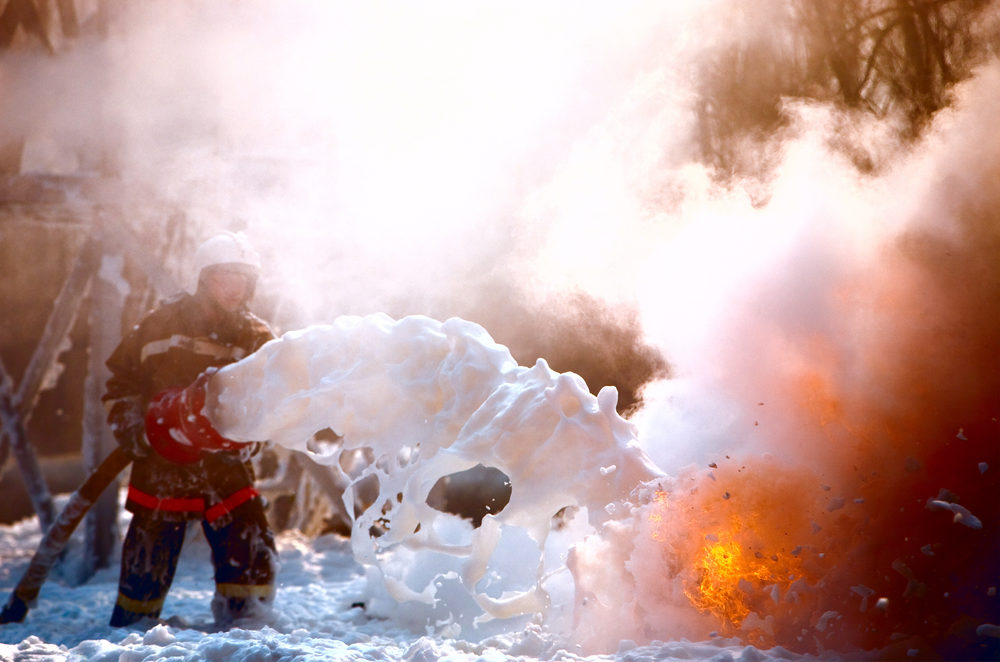Firefighters Suing Over Firefighting Foam Dangers
Firefighters have among the most dangerous jobs on the planet; from running into burning homes to spending weeks in the field battling forest fires, they risk their lives to keep us safe when every second counts. It’s reasonable to expect that the gear they use on the job will protect them, but it turns out that some of it may be putting them more at risk than even the flames.
Hundreds of current and former firefighters are suing manufacturers of specialized firefighting foam, called aqueous film-forming foam (AFFF), which is highly effective at extinguishing fast-spreading fires. AFFF’s active ingredient is a group of chemical agents called per- and polyfluoroalkyl substances, commonly called PFAS. Elevated levels of PFAS were found in the firefighters’ blood late last year, and all have developed cancer or other serious health problems.

The firefighters allege that AFFF manufacturers, including 3M, DuPont and Chemours, knew that the foam contained dangerous chemicals and did nothing to warn users. Ironically, PFAS were even found in their “turnout” coats – specially designed for their protection.
Why Is Firefighting Foam Dangerous?
AFFF was developed by the U.S. Navy and 3M in 1960. Once the Navy began using it onboard ships a few years later, concerns arose about its effects on human health. Internal documents discovered by a 2010 lawsuit against 3M revealed the company knew of these risks as early as the 1970s when lab animals exposed to PFAS developed organ damage and kept this information hidden from the public. Firefighters, along with workers in various other industries, including aviation, mining, shipping, oil and the military, continued working with AFFF daily, unaware of its carcinogenic properties.
It wasn’t until the late 1990s that the military changed its stance on AFFF, calling it hazardous waste and starting the search for an alternative. An equally-effective option has yet to be found. However, in October 2021, the White House announced a plan to reduce PFAS pollution, including a $70 million Department of Defense investment into a PFAS-free firefighting foam.
PFAS were introduced in the 1940s and are highly effective at repelling dirt, water and grease. They’re used in a huge variety of everyday household products, and research has found them in the blood of approximately 98% of Americans.
PFAS are called “forever chemicals” because they do not break down, instead accumulating over time in humans, animals and the environment. Their 2018 toxicological profile, performed by the Agency for Toxic Substances and Disease Registry, indicated that high levels in the blood could decrease the efficacy of vaccines – especially alarming during the COVID-19 pandemic.
While most people aren’t exposed to high enough levels of PFAS to cause health problems, firefighters who use AFFF daily are very susceptible to its harmful properties. They are more likely to develop cancers of the thyroid, testicles, bladder and kidney, and inflammatory bowel disease called ulcerative colitis, high cholesterol, liver damage and fertility issues. Pregnant women are more vulnerable to serious complications and even stillbirth.
States Fighting Back Against PFAS
The U.S. Environmental Protection Agency (EPA) has been working for years on regulatory measures to address the dangers of PFAS better. In 2020, the agency released an updated version of its PFAS Action Plan, which includes details on maximum contaminant levels, classifying PFAS as hazardous substances, and developing national drinking water guidelines under the Safe Drinking Water Act. They plan to dedicate nearly $5 million in research on managing PFAS in the agricultural industry.
Although federal lawmakers have introduced new legislation on PFAS, no attempt at a nationwide ban has made progress.
Dozens of states – including Washington, Michigan, Connecticut, New Jersey, Pennsylvania and New York – are taking matters into their own hands, passing legislation on PFAS regulation and restricting or banning them in firefighting foam. Several states, including New Mexico, North Carolina and Colorado, have sued PFAS manufacturers for threatening the environment and public health.
Firefighting Foam Lawsuits
AFFF manufacturers have been dealing with PFAS-related claims for years, not only from firefighters but also from government entities and private residents exposed to PFAS in soil and water. In 2017, Chemours and DuPont paid over $670 million in settlements of toxic exposure lawsuits. In 2018, cases against the foam producers were consolidated into multidistrict litigation (MDL), which will all be handled under one South Carolina federal court for efficiency. There were more than 1,800 cases in the MDL by the end of 2021, with more to come as additional firefighters continue to file suit.
The latest to file firefighting foam lawsuits are more than a dozen Massachusetts firefighters, who accused 25 companies, including 3M, of knowingly manufacturing, distributing or selling harmful products.
The filing stated that firefighter plaintiffs were regularly exposed to AFFF in the course of their normal duties and could not have known their turnout coats and other materials, as well as their blood, contained PFAS.
3M defended its products and “record of responsible use of PFAS and environmental stewardship.”
Professional Firefighters Associations (PFAs) in several states, most recently Maryland, are also joining the fight for statewide PFAS bans. During a virtual news conference, Maryland PFA member Grant Walker told lawmakers that cancer has surpassed cardiac events as the number-one cause of death in firefighters over the last two decades.








